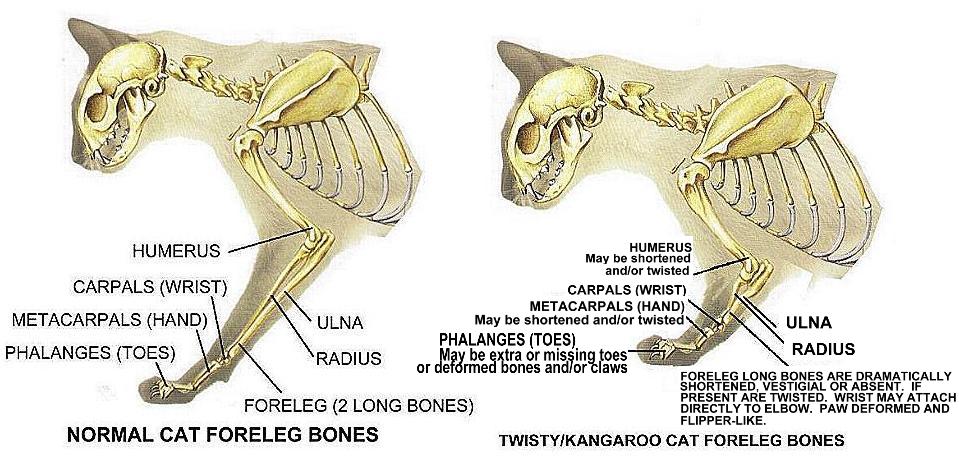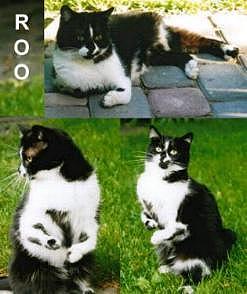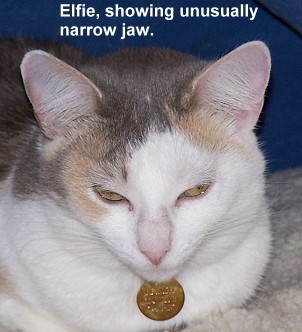
RADIAL HYPOPLASIA AND FEMORAL HYPOPLASIA
Copyright 2006-2011, Sarah Hartwell
Hypoplasias are failures of bones to grow properly. The most famous form in cats is Radial Hypoplasia or the “Twisty Cat” mutation; a disabling condition where the forelegs are abnormally short and twisted. Femoral Hypoplasia is reported much more rarely and is the failure of the long bones of the hind leg to grow properly. This page provides a summary of the two conditions. Information on caring for cats with mobility problems can be found in Caring for Disabled Cats.
RADIAL HYPOPLASIA
Radial hypoplasia (also known as radial agenesis) is the "thalidomide" or "twisty" mutation in cats. Historically, it has also been called foreleg micromelia. It is usually called by its acronym “RH”. It causes the radius – one of the two parallel long bones in the lower foreleg (between elbow and wrist) – to be unusually short. In severe cases, the bone is almost absent. The paw appears to be attached to the elbow. The humerus – the long bone in the upper foreleg – may also be unusually short so the paw appears to be attached close to the shoulder. Although it crops up from time to time through random mutation, RH became more well known when an individual deliberately bred several cats with this affliction and dubbed them “Twisty Cats” (Twisty Cats and the Ethics of Breeding for Deformity). They have also been dubbed Kangaroo Cats.
RH is known in full as triphalangeal pollex-radial hypoplasia and is caused by a dominant gene (only one copy is needed for the trait to show up). It is variable in severity. “Triphalangeal pollex” means the thumb (pollex) has three toe bones (phalanges) instead of two. This is an important diagnostic for breeders of polydactyl cats as cats with three-boned thumbs may produce kittens with hypoplasia (underdevelopment) or aplasia (absence) of the radius.

RH causes the bones of the leg to be shortened to varying degrees along with twisting due to abnormal growth. It disrupts the development of the toes causing duplication of digits. Very mild cases cause the form of Polydactyly known as “patty foot” where the additional toe(s) look more like additional finger(s) instead of the more familiar “mitten foot” where there is a distinct “thumb”. In its most severe form, it resembles the Thalidomide effect and is a crippling defect. Severely affected kittens cannot properly tread the mother’s belly to stimulate milk flow and if they survive, they cannot walk on almost non-existent forelimbs. There are many intermediate forms between these extremes.

Cats with RH tend to sit up like a rabbit or kangaroo because crouching on all 4 legs puts the chest closer to the ground than normal and puts a strain on the spine and on the deformed forelegs (Roo, owned by Jacqueline Forrest illustrates this). Because of the inequality in the size of their legs, RH cats appear to hop like rabbits, often sitting up and resting their forelegs. They might compensate for their vestigial forelegs by learning to bound on their hind legs like a kangaroo and using the tail as a support when sitting upright.
The most severely affected RH cats push themselves along with their hind legs while their useless front "flippers" scrabble or move with a swimming motion. Jumping down off an object is a problem. A cat's forelegs act as shock absorbers when it lands, but an RH cat has no shock absorbers and its chest and head will hit the ground. Some learn to get down from chairs or descend stairs backwards to compensate.
There are numerous sites to support owners of cats with RH. It is important to neuter RH cats. Although many have milder forms of RH, it is possible that their offspring would have the more severe and crippling forms and have to be humanely destroyed.
FEMORAL HYPOPLASIA
Femoral Hypoplasia (under-development of the femur) and Tibial/Femoral Hypoplasia (under-development of both femur and tibia) have rarely been described in the cat. I could only find reference to 2 cases. M Isola, E Baron & A Zotti described these in the Journal of Small Animal Practice, Volume 46, Issue 12, Page 597 (December 2005):
"Congenital or acquired feline femoral dysplasia have seldom been reported in the literature. This report describes two cases of femoral dysplasia involving the proximal epiphyses. Bilateral agenesis of the femoral head and neck (case 1) constituted an incidental finding during a post-traumatic radiographic examination, while right proximal femoral dysplasia (case 2) was observed during an orthopaedic examination for lameness. To the authors' knowledge, such imaging findings have not been reported before in cats.”
What appears to be Femoral Hypoplasia was reported in a cat owned by Becky Alvarez and communicated to me in April 2006.
Becky rescued a kitten from the wilds of Los Angeles. “Elfie” appeared to be about 10-12 weeks old, weighed 2 lbs and had very odd looking back legs. The vet, she determined by the cat’s teeth that she was actually about 5-6 months old. X-rays of the back legs showed femurs and tibiae were both about half the normal length. However, the fibulae seemed to have grown at the normal rate and so bowed out. Her hip sockets were completely unformed so that her hips slopped about when Becky tries to hold her by the back (e.g. for when the vet takes a rectal temperature). If Elfie is sitting and then decides to walk to her left or right, her feet stay in place until she has to take a step with them, then they catch up with the direction she is going. She jumps up fairly well, but when she needs to just step across a gap, e.g. from chair to chair, she has trouble bringing her back leg forward far enough to reach and often gives up the attempt. Her front legs are normal.
Elfie reached an adult weight of 5.5 lbs which is slightly heavy for her size. The vet thinks the small size may be due to early poor nutrition. There was early concern about a heart defect, but no signs of heart murmur were found when Elfie was spayed and at 2 years old there are no heart problems. She is also has a narrow muzzle and jaw, is missing a couple of incisors in front and has 2 unusual whorls in her hair that Becky calls cowlicks

Femoral Hypoplasia is better described in humans (in the form known as Femoral Hypoplasia-Unusual Facies Syndrome, or FH-UFS) and is also known as Femoral Aplasia (absence of femur) and Femoral Agenesis. In humans, it is described as bilateral (both sides) femoral hypoplasia with associated facial dysmorphism (face wrongly shaped) involving a short broad-tipped nose, long philtrum (groove in the middle of upper lip), a thin upper lip and micrognathia (small jaw - Elfie has an unusually narrow jaw). Femoral Hypoplasia is also associated with hip dysplasia and cardiovascular problems (hence the vet was concerned about potential heart problems).
A different condition called Proximal Femoral Deficiency Syndrome is due to shortening or absence of the femur due to abnormal development of the proximal portion (the part closer to the trunk), but is usually unilateral (one side only) while Femoral Hypoplasia is bilateral (both sides). Some cases of human FH also affected the tibiae and were also called "Tibial/Femoral Hypoplasia" and, like RH, this was associated with extra toes.
In June 2011, Shayla Kinsman described another cat with femoral hypoplasia, this time in an Abyssinian cat homed as a pet by the breeder. The bones in the cat's hind legs had not developed, but all the muscles were present. The cat was initially not expected to survive beyond 3 months, but was 3 years old when this case was communicated to me. Apparently he seemed to be a very content cat and could move around using his very heavily muscled front legs and muscular chest. He mainly dragged his body, but could climb and even hop with some difficulty, and was said to be able to hold his own if picked on by other cats. The only special care the owner had to do for the cat was to massage his hind legs once every few hours to stimulate blood flow, even though the cat was not partial to it. He was a very affectionate animal though.
At present I have no further information about Femoral Hypoplasia in cats and am only aware of the cases mentioned here. As with RH cats, FH cats should be neutered. Although the other 2 cases were described as congenital rather than hereditary, a genetic mutation cannot be ruled out.